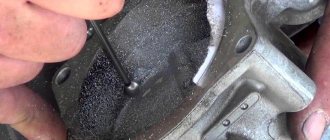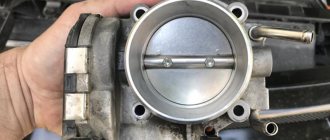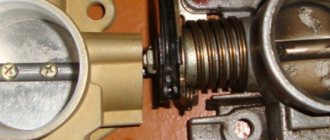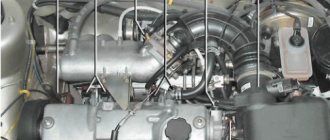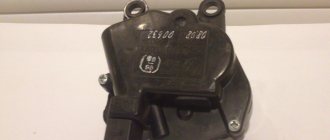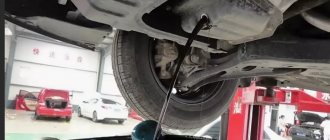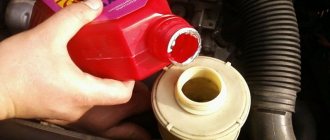In order for the car to work properly and not appear at the service station for as long as possible, except for maintenance cases, you must treat it carefully. One of the important components of the iron horse is the throttle valve. This mechanism plays an important role in the operation of a diesel or gasoline engine. And it doesn’t matter whether the power plant is carburetor or injection. The remote control can be either mechanically or electronically driven. In the latter case, sometimes it becomes necessary to adapt the throttle valve. How to do it? Let's try to figure it out, and at the same time take a closer look at the types of this node. We will also find out whether this needs to be done, and what could happen otherwise.
Purpose of the throttle valve
Not a single car in the world can do without such a unit as a throttle valve. The mechanism is a transverse channel regulator that changes the amount of flowing liquid or gas. That is, at its core, the damper is an air valve. When it is closed, the pressure in the intake system is equal to vacuum, and when it is open, it is compared to external atmospheric pressure.
By pressing the accelerator pedal, the degree of opening of the damper is adjusted. Accordingly, how much air enters the engine cylinders depends on this. Almost every modern car is equipped with an injection engine, where all important responsibilities are assumed by the electronic control unit (ECU).
As some car enthusiasts know, the optimal ratio of gasoline to air is 1:14.7. By detecting the throttle position and the amount of air using sensors, the ECU regulates the operation of the injectors and fuel pump. This knowledge will be useful in deciding how to adapt the throttle valve.
In other words, the computer commands how much fuel needs to be supplied to the engine in order to maintain optimal proportions.
Torque
To change the amount of torque, the electronic control unit can change one or more parameters:
- throttle opening angle
- boost pressure (if the engine is turbocharged)
- ignition timing
- fuel injection timing
- turning on/off cylinders
The amount of torque is constantly adjusted and depends on the following factors:
- engine starting conditions
- stable idle speed
- O2 content in exhaust gases
- restrictions on power and number of revolutions
- Automatic transmission (when shifting gears)
- traction control when braking
- forced idle when braking
- equipment operation (climate control, air conditioning)
- cruise control (whether the mode is on)
Mechanical throttle
Currently, a mechanically driven damper can only be found in budget car configurations. In such a mechanism, the damper is connected to the accelerator pedal via a metal cable, fixed to the shaft and placed in a housing on which sensors are also located:
- idle speed controller (IAC);
- throttle position (TPP).
All this looks like a separate block. Various pipes also lead to it; coolant is supplied and discharged through one, and through others the crankcase is ventilated and fuel vapors are captured.
Thanks to the IAC, the required number of crankshaft revolutions is maintained when the damper is closed. The regulator itself consists of a stepper motor and a special valve. Together they regulate the amount of air, regardless of what position the throttle valve is in. Usually there are no problems regarding how to adapt the throttle valve in the case of a mechanical drive.
Checking the readings
A car enthusiast who decides to independently adjust the throttle position sensor should remember that this should be done on a warm power unit. First you need to decide on the structure of this device. To adjust, you will need to find 2 connectors. The one at the top is the connector of the sensor itself, it is brown. Below it is the sensor enable connector. It is usually marked in gray. But some models may have different markings.
Next, the device readings are checked. The engine starts and warms up to operating temperature. First of all, check the input signal. To do this, pierce the rubber seal on the upper contact with a needle, connect the positive terminal of the multimeter to it, and take the negative terminal from the engine. The readings should be quite definite, although slight deviations may be allowed.
The voltage will be as follows (engine running):
- Power wire - 5 V;
- Idle speed – 0.5 V;
- At 2000 rpm – 0.55-0.6 V.
With the engine off but the ignition on:
- Starting position, damper closed – 0.7 V;
- Pedal depressed (damper fully open) – 4 V.
In this case, the voltage should gradually increase as the damper opens. When carrying out voltage measurement work, be as careful as possible. Remember that any awkward movement can lead to a short circuit and failure of all electronics.
To check the functionality of the sensor, measure the resistance at the terminals. This is done with the engine not running. The readings of a working sensor should be as follows:
- Damper closed – 0.8 kOhm;
- The damper is open - 4.7 kOhm.
When the readings differ, adjustments should be made. If there is no voltage at all, check the wiring. If the resistance is too high, it is better to change the sensor; most likely, a breakdown has occurred. In all other cases, the throttle position sensor is adjusted.
Electromagnetic throttle valve
The electronic analog, unlike a mechanical unit, allows you to achieve the optimal torque value in any engine operating mode. The level of fuel consumption is reduced, and driving such a car is comfortable and safe. The main distinctive features (and in this case, advantages) are the following:
- idle speed is controlled by moving the throttle valve;
- there is no mechanical connection between the pedal and the damper.
Due to the fact that there is no mechanical connection, torque can be controlled electronically instead of the gas pedal. The damper module itself consists of the following elements:
- housings;
- the damper itself;
- electric drive;
- return spring mechanism;
- damper position sensors.
Installing not one, but two damper position sensors in the module will improve reliability. For this purpose, magnetoresistive devices or potentiometers with sliding contacts can be used. It is precisely because of the breakdown of these elements that it is necessary to decide how to adapt the throttle valve on many cars.
If a malfunction occurs in the electric drive, the damper is brought to the emergency position due to the return spring mechanism. In this case, the module itself must be replaced, which can only be done as an assembly.
Electronic gas pedal Lada Granta
On modern cars, instead of the usual cable drive for throttle control, a so-called “electronic gas pedal” is installed. In such cars, the throttle position is controlled electronically. When you press or release the gas pedal, information about this goes to the control unit (ECU) and only after processing and adjustment is a command given to the throttle module. The pros and cons of such a system, as well as signs of malfunctions, will be discussed in this article.
For those who are accustomed to mechanical drives, where pressing the gas pedal directly causes the throttle to move, driving a car with an electronic system will be unusual and unknown. To understand, you need to understand the principle of operation of the “electronic pedal” and its difference from a conventional mechanical one.
Throttle valve clogged and cleaning intervals
From time to time, the throttle valve inevitably becomes clogged, which manifests itself in various ways. In this regard, a reasonable question arises: how often should it be cleaned? It is not entirely possible to answer this unequivocally, since there are no recommendations on this matter. Some car owners visit auto repair shops when they suspect an engine problem.
Some people believe that the damper needs to be cleaned after every 40,000-50,000 km. Others have a different opinion and clean the damper more often, after 30,000-40,000 km.
Typically, black carbon deposits on the valve indicate low quality fuel. When operating a vehicle with such gasoline, there is a risk of oily deposits forming. After this, there should be no question whether the throttle needs to be adapted.
As a rule, if the piston group is experiencing some problems, then a characteristic sign is the valve becoming coked with soot and oily impurities. Sometimes this indicates crankcase ventilation is clogged.
Recommendations
Comments 62
I understand that it is necessary to open the floor of the injector?
No, everything is extremely simple. Remote control mounting - 2 nuts in total
How long is the nut?
The last picture is very interesting. It turns out that the lower pipe goes from the throttle to the small crankcase breather? And the upper pipe goes from the throttle to the receiver, as I understand it?
Yes, the low ventilation and adsorber pipes have been swapped. This was done on the repeated recommendation of Drayvovites.
I don’t have an absorber (Can’t this modification be done without it?)
They suggested that I transfer the low ventilation pipe to a free fitting on the plastic intake manifold. But I wasn’t impressed with the piece itself - it’s a little poorly made, without wedge-shaped chamfers
Somehow, in the open spaces of the drive, I already read about a similar modification, more precisely about the transfer of the low crankcase ventilation hose... Since there is no absorber, I’m thinking. And if you just transfer the lower throttle pipe into the engine where there is a small breather or whatever it is called... And transfer the upper pipe from the throttle to a plastic receiver?
I won’t say anything intelligible, it’s not my topic. Highly recommended - did it. It didn't get any worse.
I fucked with it... the first time I figured it out, but the second time I didn’t think about it... but it started spinning due to vibration and more air began to flow... as a result, the edges on the damper were worn out and it began to suck a lot of air. had to change
It turned out to be a good thing)
Test. If the space allows, another grower would not be a problem.
The place is at its limit. There will be no grower
Can you tell me more about the initial opening angle? I just have that hemorrhagic problem with him. Once upon a time, when the 54th damper was installed, one mechanic decided to adjust it and climbed where it was not necessary. It seems like the angle was set, but something was wrong.
This is only 1-2 degrees. I made sure that the damper was in the stop position, that is, completely closed, but not jammed. Started it up and warmed up the engine well. Tracking IAC steps - reg. Use the screw to slightly open the damper until the steps are reduced to 25-35 from 45-50. That’s all the adjustment. The TPS voltage varies within 50-100 mV no more. The initial position of 0% is retained. During the adjustment process, it is worth turning off the engine, waiting for the ECM to turn off and starting it again - to perform adaptation to “0” TPS
I did this, then the gap turns out to be very large and at 25-35 steps the revolutions begin to float. Stable only from 35-45. Moreover, if the gap is too large, the traction deteriorates. Those. It feels like the motor is wrapping an elastic band around itself. I reduce the gap, everything is ok, but the steps reach 50.
I have no complaints about stability. But the failures when releasing gas have disappeared
Those. There is no specific panacea in our cars?! For example, Ford has a gap of 0.05, I installed the same on ours, it seems to work, but it doesn’t seem to work.
Moreover, the reason for the appearance of the described failures is still unknown. They just appeared in May last year. Especially annoying in rainy weather with a loaded generator.
Signs of a clogged damper
When the throttle valve becomes clogged, the engine begins to operate in an unstable mode. Typical signs of a malfunction in this case are:
- increased idle speed;
- delayed engine response to pressing the accelerator pedal;
- while the car is moving, jerks are observed, and sometimes the vehicle changes speed independently, without the driver’s participation;
- abruptly releasing the gas pedal causes the power plant to stop.
In some cases, the CHECK indicator on the instrument panel will light up. Sometimes tar deposits settle on the throttle shaft, causing it to seize. Then the gas pedal is pressed with noticeable force.
Before moving on to solving the problem of how to adapt the throttle valve on a Skoda or any other car, you need to make sure that the diagnosis is accurate by conducting a visual inspection of the mechanism. To do this, you need to remove everything that is possible in order to open access to the module. Be careful not to accidentally disconnect the cooling system pipes.
Problems with the DAAZ 2107 carburetor
Despite the fact that the device is reliable and durable, units that are more than 30 years old are also in use today. During such a period of use, the likelihood that the car owner will encounter various kinds of problems is quite high.
What malfunctions are typical for Dimitrovgrad-made carburetors:
The engine stalls when you press the gas
At the moment of start or when idling, the power unit may stall when the driver smoothly presses the pedal.
Why does this happen:
- The holes in the transition system of chamber 1 may become clogged. They need to be blown out or treated with a cleaner.
- The accelerator pump is broken. It is replaced or repaired.
It is also possible that when moving while gas is supplied, the engine jerks and may stop. To prevent this, you urgently need to press the pedal again.
What does this mean:
- The channels, jets or emulsion well are clogged. The defect can be eliminated by cleaning the elements.
- The nozzle of the dosing system of chamber 1 is not screwed in completely. It needs to be wrapped.
- The jets are not selected correctly.
- The fuel level in the float chamber is insufficient, which is regulated by setting the float and valve.
- The filter installed at the inlet is dirty. It needs to be dismantled and cleaned.
- Poor condition of sealing elements that need to be replaced.
The ignition system may also be faulty.
Pouring gasoline
This problem is encountered quite often. Usually it lies in a malfunction of the metering units or the vehicle’s fuel system.
- malfunction or leakage of the needle valve;
- leakage or breakdown of the float;
- the float touches the walls when moving around the chamber;
- the fuel level in the float chamber is exceeded;
- the jets supplying air are clogged;
- fuel pump failure.
Knowing the design of the carburetor, it is not difficult to find the source of the problem.
Shoots
The power unit may shoot into the carburetor. Such pops can be heard both at start and when moving at speed. This leads to high fuel consumption, engine overheating, unstable idling, and also to the fact that the engine cannot develop full power. Shooting indicates improper adjustment of the fuel-air mixture preparation and gas distribution system.
Gasoline is not supplied
If fuel does not flow into the carburetor, there can be many reasons.
Main sources of problems:
- fuel filter contamination;
- ice formation in the gas pipeline;
- leaks at fuel line connections;
- interference in the hose that comes from the gas tank;
- fuel pump failure;
- contamination of the carburetor filter element.
The second camera does not work
In carburetors with two chambers, it is possible to increase the efficiency of the power unit while maintaining excellent power parameters. However, the 2nd compartment often fails.
The malfunction may be related to:
- flooding due to contamination of fuel channels;
- incorrect clearance settings;
- malfunction of the throttle valve drive;
- poor condition of the pneumatic drive diaphragm;
failure of any elements: jets, diffuser, economizer XX, etc.
Accelerator pump does not work
Problems in the functioning of this unit lead to the fact that gasoline does not flow or is supplied under the wrong pressure, resulting in difficulties with acceleration. As a rule, the reason for the lack of fuel supply is a clogged fuel nozzle of the accelerator unit or a ball sticking to the check valve bushing
If the jet does not have enough pressure, you should pay attention to the condition of the ball and its position, as well as the leakage of the diaphragm connection, which is located between the top cover and the body. To fix the problem, you need to clean the components and evaluate their condition.
Cleaning the remote control
If the cause of unstable engine operation is a dirty damper, you should move on to cleaning it. To do this, you can contact a reliable service station. Among the large number of workshops, you can find one that specializes in specific brands (Audi, Volkswagen, Toyota, Mercedes and others). However, the owner can do all the work himself, since much experience and skills are not required in this matter.
At service stations, the cost of the procedure may depend on a number of factors:
- complexity of the work - for some cars, access to the remote control will require the dismantling of many parts;
- service station service level - as a rule, the larger the organization, the more expensive it is;
- location – in large cities you can leave more money than in the periphery.
Cleaning the throttle valve is a simple procedure, after which you usually need to think about how to adapt the throttle valve on a Nissan or any other car.
Any car owner can perform this procedure independently. No special knowledge or skills are required here. All you need to get to the damper are tools and rags (preferably soft ones). You also cannot do without a special product - mainly the carburetor cleaner “Carb Cleaner” is used.
Problem with idle float when starting on cold due to sticking of throttle 21127 and 21129.
Dear friends, today I’ll tell you about my experience in resolving problems with the throttle assembly. Very relevant, especially for owners of 21129 engines.
By the way, I have the firmware with the problem already fixed.
The occurrence and solution at the plant level in the case of the M74.5 ECU, it was like this. When the ignition was turned on on old versions of the ECU firmware, the micro-calibration time of the Throttle Unit (hereinafter referred to as the remote control) was, well, long, due to the fact that the owner did not wait for a 10-second pause during the ignition, this error occurred.
This problem can be fixed with firmware.
But not everyone, for example, in cars of 13-14 years, the remote control motor was of an old model, had a certain moment of jamming, then in 15 the remote control became “modernized” and this error went away altogether.
Firmware versions that have this problem:
I427DB02 I427DC03 I427DD04 I427DF04 I427DG05 I427GA01 I427GB02 I427GC03 I427GD04 I427GE05 I427GF06
Firmware versions that do not have this problem:
I427GG07 I427GKA1 I427GKA 2
Here is a photo of how to find out your firmware version, the firmware is interchangeable, at least install the oldest one on the new unit, at least the newest one.
Problem with floating XX when starting on cold
The car sits overnight, in the morning you start the revs, when it warms up, the revs begin to jump, +-300 revs, with the probability of stalling, you need to press the gas pedal lightly and everything returns to normal.
Starting the engine, the rpms are 1200, they begin to jump between 500 and 1400 and hang at 700.
Related problems:
— Jerking during a smooth start in first gear — Thoughts in part-load mode — The feeling when accelerating at 50% throttle that sometimes “as if you’re holding your ass”
How to diagnose physically: when disassembling the throttle, remove the plastic gear, twist the motor gear, if it rotates tightly or sticks, then the manual is for you.
It is necessary to remove the remote control, clean the valve (by the way, it was clean) with carburetor cleaner, then remove the cover, unscrew the motor and wash everything.
Source
Self-cleansing procedure
If the damper is electronically actuated, then it is better to remove the negative terminal of the battery. Next, you can do everything according to simple instructions:
- dismantle the air filter by unscrewing the pipe clamp;
- disconnect all connectors of the throttle module and other pipes;
- move the air filter receiver to the side so that it does not interfere, and begin cleaning the damper;
- upon completion, reassemble the damper module in reverse order, checking that everything is in place;
- After assembly, start the engine and check the idle speed.
In some cases, before you begin to adapt the throttle valve on a Toyota, Nissan or Skoda, it is necessary to remove the throttle itself, which allows you to completely clean the valve. To do this, you will need a 5 mm hexagon to unscrew the 4 fasteners. Removing the throttle should be done with great care, as there is a risk of damaging the gasket.
If, after cleaning the throttle body, increased idle speed is observed, it means that the damper needs to be adapted. What this is is further in the topic of the article.
Owner reviews
Owners of LADA XRAY who independently performed the throttle valve zero adaptation procedure note that the car stopped twitching and acceleration became smooth.
Some reviews from Drive2.ru (link to post):
Let us remind you that we previously published an information letter from AVTOVAZ, which tells us what to do in case of vibrations and jerks when starting off a LADA car.
Share on social networks:
Found an error? Select it and press Ctrl+Enter..
Source
The need to adapt remote sensing
This definition refers to the operation (or training) that is carried out so that the ECU “knows” what position the throttle valve is in relative to the degree of depression of the accelerator pedal. This procedure is simply necessary if the engine is unstable at idle.
For most Toyota, Lexus, Mercedes, Nissan, and Audi cars, it is necessary to adapt the throttle valve, as this allows you to eliminate the malfunction. The procedure is performed in the following cases:
- in the event of a critical drop in the voltage of the on-board network (the battery is switched off or completely discharged);
- the ECU was replaced;
- the valve was cleaned and the throttle was removed;
- when replacing the throttle module itself;
- the accelerator pedal was replaced, usually with an electronic one.
It is worth noting that due to the layer of dirt, the gap between the damper and the body changes, and after cleaning the damper, its position has changed. But the ECU “has no idea” about this and continues to control the fuel supply according to previous indications (before the cleaning operation). Adaptation will completely eliminate this gap and restore engine performance.
Causes
The most common reason for an adaptation to be made is the consequences of throttle valve maintenance. As a result of operation, a large amount of deposits forms in this unit, therefore, after flushing, the position of the throttle valve changes, and the ECU continues to send signals about its condition until maintenance.
Over time, natural wear occurs on the resistive layer of the sensor potentiometer and the moving elements of the throttle valve; in this case, after adaptation, it will most often require replacement. It is necessary to conduct training if changes are made to the ECU settings (chip tuning), especially if operations have been performed to increase engine power.
The procedure is performed using special programs on computer equipment or without them (a strictly defined procedure, which will be discussed below) depending on the brand of car. Auto electricians must take into account the features of the model, year of manufacture, and type of ECU installed on the vehicle.
The simplest way to carry out adaptation
Now the question of whether it is necessary to adapt the throttle valve after cleaning should definitely not arise if there were still doubts. The easiest way to carry out the operation is to simply reset the battery terminal. Just to begin with, it is worth warming up the engine well to operating temperature, for which you should take a short trip. Then, turning off the engine, disconnect the negative terminal of the battery and wait. Depending on the brand of car, the waiting time can be 10-30 seconds or 15-20 minutes.
During this period, all ECU parameters should return to the original (factory) settings. Next, all that remains is to connect the terminal and start the engine - the speed should return to normal.
Resetting and setting service intervals
In more or less modern cars, it is possible to set the mileage before service, when the tidy will remind the driver to go and change the oil. The standard interval is 15,000 km.
Resetting the service interval
Firstly, resetting it after changing the oil with VAG-COM goes like this:
- Login to Dashboard
- Adaptation button
- 2nd channel
- Save existing value
Setting the service interval
And setting the intervals (depending on the car!, instructions are given for common A4 8E bodies):
- Login to Dashboard
- Adaptation button
- Channel 42 (minimum value, thousand km)
- Channel 43 (maximum value, thousand km)
- In each of these channels save the required values
Accordingly, if, for example, you write the number 5 in the 42nd channel, and 7 in the 43rd channel, it turns out that after 5 tkm the indication “2 tkm before service” will light up, and at 7 tkm a persistent recommendation to go to the service will appear
Additional service display settings
On those devices where In1 or In2 (ln1 ln2) lights up:
In a vag coma:
- Block 17 - toolbar (instrument)
- Button 10 - Adaptation
- Channel 05 - OIL in thousands of kilometers
- Channel 06 - In1 in thousands of kilometers
- Channel 07 - In1 in tens of days
- Channel 08 - In2 in thousands of kilometers
That is, an example: we go to channel 6 and set it to 10. 10 means that the next time In1 will light up after 10 thousand km.
We thank MrKrabs for the second part of the description.
Adaptation using the example of some cars
Another method, which we will consider using the example of one well-known German brand, also involves adaptation without a computer. Here you should warm up the engine to a temperature of approximately 70-99°C. The battery voltage must be at least 12.9 Volts when the engine is not running. The action plan for how to adapt the throttle valve on a Volkswagen will be something like this:
- After warming up and turning off the engine, you should wait a short period (5-10 seconds).
- With the gas pedal released, turn on the ignition and wait 3 seconds.
- After 3 seconds, you need to press the accelerator pedal all the way 5 times and release it back. Act quickly, as you only have 5 seconds to do this.
- After the 5th exercise, you should wait a pause.
- After 7 seconds, press the pedal all the way again and hold it in this position until the “CHEK” indicator starts flashing (≈ 10 sec.), then it should remain on continuously (≈ 20 sec.).
- When the indicator lights up constantly, count to three and only then release the pedal.
- Start the engine (repeat if necessary), wait 20 seconds, then lightly accelerate (2000-3500). If the tachometer shows 700 rpm at XX (+- 50), it means that the adaptation was successful.
In this case, it is necessary to strictly adhere to the time intervals of each setting step. This is the only way the ECU training will go smoothly. But before that, it’s worth studying the adaptation features and the possibility of a manual procedure for your car. Perhaps only service station specialists can help.
Initial conditions
Mitsubishi Lancer 9 how to clean the throttle valve
Before starting operations, make sure that all the conditions listed below are met.
This process is canceled if any of the conditions are not met at the time of execution.
- The battery voltage is not lower than 12.9 at idle.
- Temperature from 70 to 99 degrees.
- Selector in P or N (automatic transmission).
- Electrical loads are turned off (air conditioning, headlights, heated rear window, cars with Eurolights - turn on the dimensions).
- The steering wheel is in the middle position - the wheels are straight.
- Before training, drive a car for 10 minutes.
- The radiator fan should not work.
- Vehicle speed: The vehicle is stationary.
- Gearbox: Warm up.
Owner reviews
Owners of LADA XRAY who independently performed the throttle valve zero adaptation procedure note that the car stopped twitching and acceleration became smooth.
Some reviews from Drive2.ru (link to post):
Let us remind you that we previously published an information letter from AVTOVAZ, which tells us what to do in case of vibrations and jerks when starting off a LADA car.
Share on social networks:
Found an error? Select it and press Ctrl+Enter..
Source
Owner reviews
Owners of LADA XRAY who independently performed the throttle valve zero adaptation procedure note that the car stopped twitching and acceleration became smooth.
Some reviews from Drive2.ru (link to post):
Let us remind you that we previously published an information letter from AVTOVAZ, which tells us what to do in case of vibrations and jerks when starting off a LADA car.
Share on social networks:
Found an error? Select it and press Ctrl+Enter..
Source


